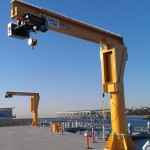Safe crane operations can only be guaranteed by a proper training. Therefore, the operators of the boom cranes need to be properly trained so that serious accidents can be avoided. Furthermore, for safe operations, the operators need to be familiar and to understand how to use the load charts which are provided by the boom crane manufacturers, such as safe practices for hoisted loads, swing radius and load chart information, and recommendation for boom cranes set-up and rigging. Workers must be careful not to put themselves in dangerous situations where they can get struck by falling loads or collapsing boom crane components. Safe work practices for workers and operators are required by the law and should be followed. Check out our safety tips to prevent injuries when boom cranes are used on the work site:

For employers:
- Maintain and inspect the boom cranes by following the manufacture’s recommendation;
- Ensure proper communications between the operators and riggers, supervisors, spotters and other workers around the boom cranes;
- Use standard hand signals and provide training for signal persons;
- Follow work safe practices when working near energized power lines;
- Even if not required by the law, require operator testing and certification as prerequisite for employment;
- Review you occupational safety programs and standard operating procedures to ensure they include lifting load safe practices;
- Develop and follow a written engineered lift plan for critical lifts;
- Watch for signs of soft or unstable grounds;
For Boom Crane Operators:
- Complete the training program which is provided by your employer;
- Always use the manufacture’s load chart;
- Do not exceed the equipment lift capacity;
- Use a spotter (if necessary) to ensure protection while hoisting and swinging loads;
- For proper outrigger deployment, follow the manufacture’s procedures. This will ensure a proper boom crane set up with outrigger pads supported on firm and stable surfaces;
- When working around trenches, excavations or back-filled location next to new building construction sites, use extreme caution;
- On soft grounds, place specifically designed mats, timber pads, plates or concrete rafts under the boom cranes;
- Be aware of power lines and other obstacles.
- Avoid hoisting or moving suspended loads over workers and other people around.


